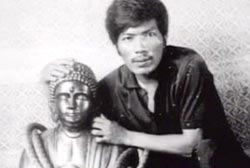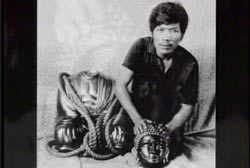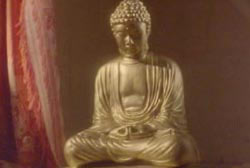
|
|||
Lost Treasure: Ferdinand Marcos Gold Buddha
Source : http://en.wikipedia.org/wiki/Yamashita%27s_gold
Yamashita's gold Yamashita's gold, also referred to as the Yamashita treasure, is the name given to the alleged war loot stolen in Southeast Asia by Japanese forces during World War II and hidden in caves, tunnels and underground complexes in the Philippines. It is named for the Japanese general Tomoyuki Yamashita, nicknamed "The Tiger of Malaya". Though accounts that the treasure remains hidden in Philippines have lured treasure hunters from around the world for over fifty years, its existence is discounted by most experts. The rumored treasure has been the subject of a complex lawsuit that was filed in a Hawaiian state court in 1988 involving a Filipino treasure hunter, Rogelio Roxas, and the former Philippine president, Ferdinand Marcos The looting and the alleged cover-up Prominent among those arguing for the existence of Yamashita's gold are Sterling Seagrave and Peggy Seagrave, who have written two books relating to the subject: The Yamato Dynasty: the Secret History of Japan's Imperial Family (2000) and Gold Warriors: America's Secret Recovery of Yamashita's Gold (2003). The Seagraves contend that looting was organized on a massive scale, by both yakuza gangsters such as Yoshio Kodama, and the highest levels of Japanese society, including Emperor Hirohito. The Japanese government intended that loot from Southeast Asia would finance Japan's war effort. The Seagraves allege that Hirohito appointed his brother, Prince Yasuhito Chichibu, to head a secret organization called Kin no yuri ("Golden Lily"), for this purpose. It is purported that many of those who knew the locations of the loot were killed during the war, or later tried by the Allies for war crimes and executed or incarcerated. Yamashita himself was executed by the U.S. Army for his war crimes on February 23, 1946. The stolen property reportedly included many different kinds of valuables looted from banks, depositories, temples, churches, other commercial premises, mosques, museums and private homes. It takes its name from General Tomoyuki Yamashita, who assumed command of Japanese forces in the Philippines in 1944. According to various accounts, the loot was initially concentrated in Singapore, and later transported to the Philippines. The Japanese hoped to ship the treasure from the Philippines to the Japanese Home Islands after the war ended. As the War in the Pacific progressed, U.S. Navy submarines and Allied warplanes inflicted increasingly heavy sinkings of Japanese merchant shipping. Some of the ships carrying the war booty back to Japan were sunk in combat. The Seagraves and a few others have claimed that American military intelligence operatives located much of the loot; they colluded with Hirohito and other senior Japanese figures to conceal its existence, and they used it to finance American covert intelligence operations around the world during the Cold War. These rumors have inspired many hopeful treasure hunters, but most experts and Filipino historians say there is no credible evidence behind these claims. In 1992, Imelda Marcos claimed that Yamashita's gold accounted for the bulk of the wealth of her husband, Ferdinand Marcos. Many individuals and consortia, both Philippine and foreign, continue to search for treasure sites. A number of accidental deaths, injuries and financial losses incurred by treasure hunters have been reported. At present, the Mines & Geosciences Bureau of the Department of Natural Resources of the Philippines is the Filipino government agency that grants treasure permits. 
From 1965 to 1986, Ferdinand Marcos ruled the Philippines—first as an elected leader, then as a dictator. By the time Marcos was deposed, his personal wealth was estimated at $10 billion. Few dared to challenge Marcos publicly. But on May 5, 1971, a man named Roger Roxas defied Marcos and went public with a daring accusation. He accused the dictator’s soldiers of stealing a rare, solid gold Buddha worth millions. In 1970, Roger Roxas and his family lived 200 miles north of Manila on the Philippine island of Luzon. On weekends, Roger spent his time treasure hunting with a large group of Filipinos. One of Roger’s fellow treasure hunters was Albert Fuchigami. Albert had been shown a treasure map by his father, who was an officer in the Japanese Army during World War II. The map pinpointed the location of a secret tunnel system where the Japanese had left behind a fortune in gold bars. Roger was confident his friend was telling the truth: Roger Roxas and Albert hired a crew to excavate the site. In the first few minutes of digging, they found a layer of Japanese shrapnel. A few weeks later, the crew broke through into the tunnels, which the Japanese had apparently dynamited shut. The tunnel system was elaborate, complete with railroad tracks. They found that one explosion had blocked all access to the main underground passageway. Undaunted, they dug around it. Roger Roxas was the first to enter: “To my surprise, I found several Japanese skeletons. There must have been more than 10.”
According to Roger, there were handfuls of diamonds inside the Buddha. Some were rough-cut and some fine. Roger hid the diamonds in a closet. That night, Roger’s brother took pictures of Roger with the Buddha. Roger thought the pictures might protect him, but he was wrong. News of his discovery had already spread all the way to the President’s palace in Manila. Although the Philippines was a democracy, Ferdinand Marcos, along with his wife, Imelda, ruled like a king with an iron hand and brute force. Two months after Roger brought the Buddha home, soldiers invaded his house. The red ribbons on their rifles indicated that they were members of President Marcos’ elite Palace Guard. Then out of nowhere, the potential buyer appeared. Roger had been double-crossed: “They took everything, even the piggy banks of my children. Whatever my wife inherited, all her jewelry, all the diamonds in the closet. They took all of it. If we had fought back, they would just have killed us.” The next day, Roger and his brothers reported the incident to the local police. Then he went to visit Judge Pio Marcos, a family friend: “I told him, judge, why did you let them confiscate my treasure, we’re friends. He said, Roger there is nothing that I can do. I said why? He said because the prince asked for it. I said who’s the prince. And he said the prince, President Marcos.” According to Roger, the judge warned him that Marcos had put a price on his head. Roger and his family fled to an isolated jungle village to hide. 
While Roger remained secluded, Filipino reporters had already gotten a hold of the story. Marcos allowed the press to view the Buddha. But his political opponents felt that Marcos had substituted a fake. They wanted to embarrass Marcos, so they tracked down Roger and convinced him to return to Manila to identify the Buddha. Marcos was outraged. Once again, Roger went into hiding. But according to Roger, two weeks later he was tracked down by the Palace Guard: “Three men approached me and pointed their guns at me. They knew me. They told me Roger, come with us in the car, we will bring you to Manila. I could not escape. I couldn’t escape. I knew they were soldiers. They had guns. They called the palace and they were speaking English. I knew that it was Marcos they were talking to because they addressed him as Mr. President. Marcos must have asked them, are you sure it is Roger Roxas that you captured. And they said yes, we’re sure.” The soldiers locked Roger in a hotel and tortured him until he signed a paper stating that he was paid off to lie about the Buddha. The soldiers also wanted Roger to tell them where the gold was hidden. He was tortured daily for several weeks. But Roger had no intentions on telling the soldiers anything: “I made a promise to Mr. Fuchigami. I told him even if they to kill me, I will not tell them where the tunnel is.” Eventually, Roger was allowed to see his family: “My wife was crying. She was surprised. And she said what is happening to you. You know they might kill you. And I said just pray, and then the soldiers took me again.” After the brief visit with his family, Roger was taken back to the same hotel where he had been tortured. But this time, he managed to escape through a window in the restroom. After fleeing the hotel, Roger Roxas went into hiding. He never saw the golden Buddha again. At least two witnesses claim to have seen the Buddha at one of Marcos’ summer palaces. Ferdinand Marcos died in 1989, but rumors persist that his family still has the golden Buddha. comments powered by Disqus Submit News/Videos/Links | Discuss article | Article Link | More Unsolved and Unexplained Mysteries |
More can be addded on request. Direct your requests at vinit@theunexplainedmysteries.com
